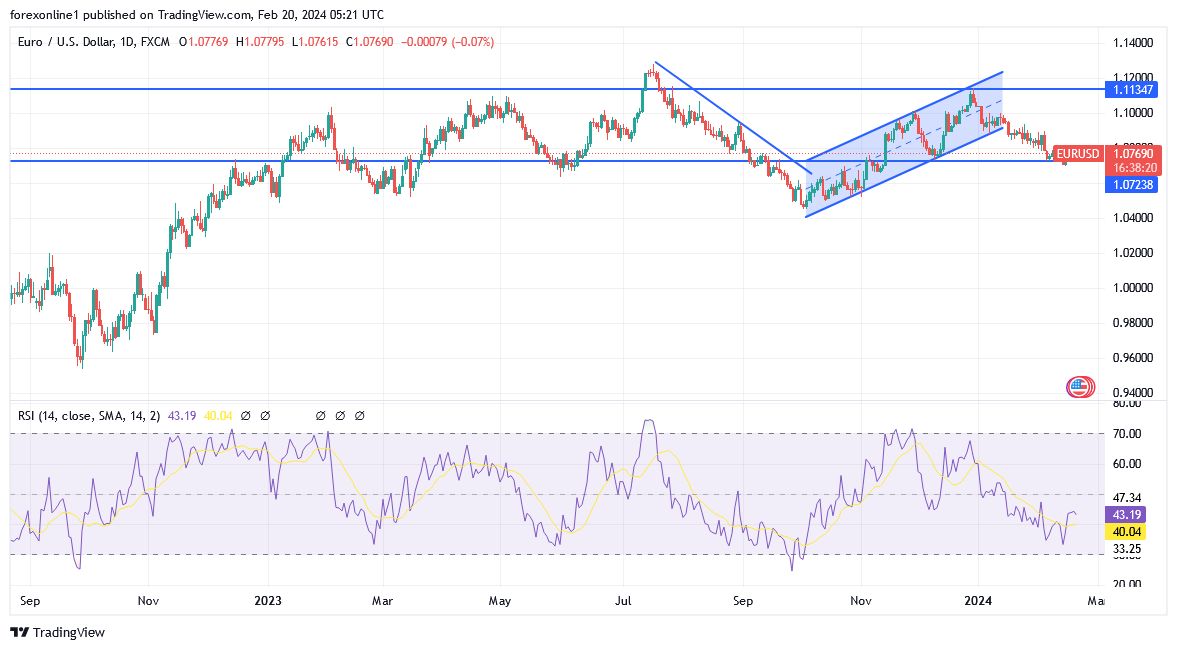- According to recent forex trading, EUR/USD found strong support at 1.07 and we maintain a bullish bias for the next five days with the possibility of a positive surprise from the PMI data to clarify this position.
- As we expected, the price of the Euro/Dollar stabilized in a narrow range amid the American holiday yesterday, between the level of 1.0762 and the level of 1.0789.

Last week showed us that the 2024 US dollar rally was starting to look a bit old, with a series of economic data that exceeded consensus unable to push the euro/US dollar price below the 1.07 support level. This suggests a slight improvement in the near-term outlook for EUR/USD. In this regard, Sean Osborne, senior currency analyst at Scotiabank, says, “The short-term trend momentum favours more euro strength in the short term.” Support will be at the levels of 1.0755 and 1.0690/00.
The analyst added, “The euro’s gains from the mid-week low are still holding and leave immediate trading near levels that could indicate more sustainable gains in the short term.” Goldman Sachs' Forex desk notes good demand for EUR/USD in the wake of last week's US retail sales numbers, indicating frustration that the EUR/USD pair's decline has stalled back below the 1.0700 level. Therefore, this has led to some “reduction in what is arguably among the largest foreign exchange centres out there.” Meanwhile, Goldman Sachs traders reported that the EUR/USD rate “appears to have found buying interest at the immediate lows of 1.0700.”
Top Forex Brokers
In general, we expect this support to continue this week, especially as the incredibly low volatility currently seen in the currency market indicates a slim possibility of a major collapse in the euro against the dollar. Any recovery in the euro-dollar pair in the coming days is likely to be limited near the 100-day moving average, currently at the level of 1.08. also, we note that the pair has failed to close above this level since February 2nd and attempts to test this level have been rejected throughout the month so far.
However, there is some good data from the Eurozone this week, with a focus on the preliminary Purchasing Managers' Index (PMI) on Thursday for February. The market is looking for the Services PMI reading in the Eurozone to be at 48.7, Manufacturing at 47, and Composite at 48.3; any reading below 50 indicates contraction. The basic rule is that the euro could come under pressure if the data come in below the expected levels.
Top of Form
Ultimately, with so much economic gloom brewing for the Euro, we believe it will take a significant effort to depreciate the currency. Instead, risks are skewed to the upside with a greater reaction to any better-than-expected prints. In a weekly assessment, UBS says preliminary PMIs could show signs of a potential rebound in activity, which would be positive for the euro... Economic data surprises have been a bit stronger in recent weeks, which typically helps the euro.
Furthermore, it is expected that German Gross Domestic Product (GDP) figures will be released on Friday, with an anticipated reading of -0.2% on a quarterly basis for the fourth quarter, confirming the technical recession due to the third-quarter reading of -0.02%. Additionally, the IFO Business Climate Survey is scheduled to be released on Friday, providing timely assessments of economic conditions and expectations, which could offer market insights into whether the worst is over for the largest economy in Europe. (The current assessment is expected at 87, and expectations at 83.80).
EUR/USD Technical Analysis and Forecast:
The EUR/USD price continues to trade within the downtrend channel on the four-hour time frame, and the upcoming resistance test may provide another short-term opportunity. Technically, the channel top is lined up with the dynamic resistance 100 SMA and the 50% Fibonacci retracement level near the key psychological mark of 1.0800, making it a key entry point for EUR bulls. If this continues as a ceiling, the EUR/USD price may slide back to its lowest levels of 1.0698 or lower. Moreover, a higher pullback could still reach the 61.8% Fibonacci level at 1.0822, but a break above this could signal that a reversal is underway. Ultimately, the 100 SMA remains below the 200 SMA to confirm that the overall trend remains bearish, or that sell-offs are more likely to gain momentum rather than reverse. Also, the stochastic oscillator is approaching overbought territory to reflect exhaustion among buyers, so heading lower means sellers have regained control.
At the same time, the Relative Strength Index has more room to rise before reaching the overbought area, and therefore the correction may continue until it reaches there.
Ready to trade our daily Forex analysis? We’ve made a list of the best forex trading accounts worth trading with.
